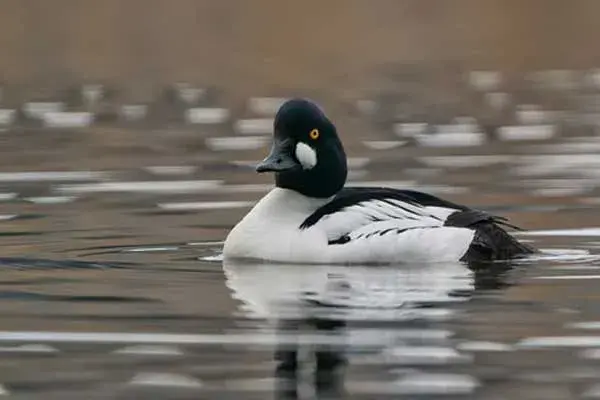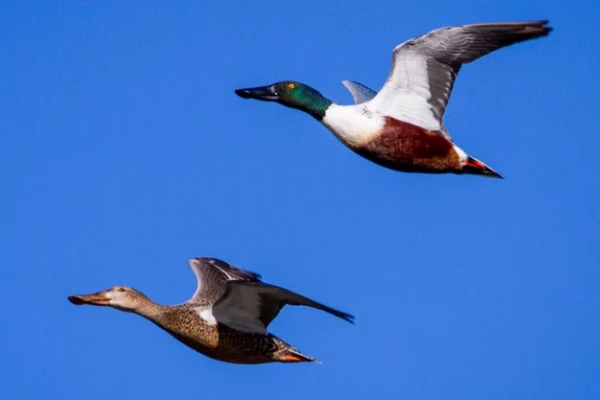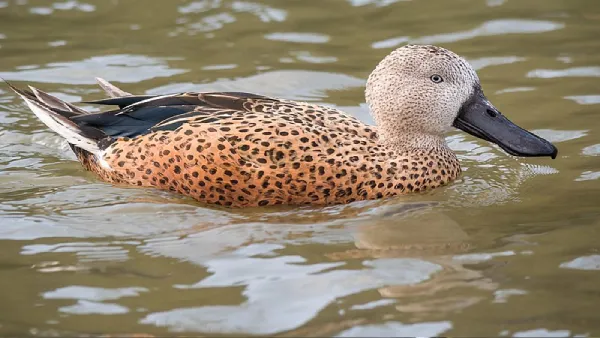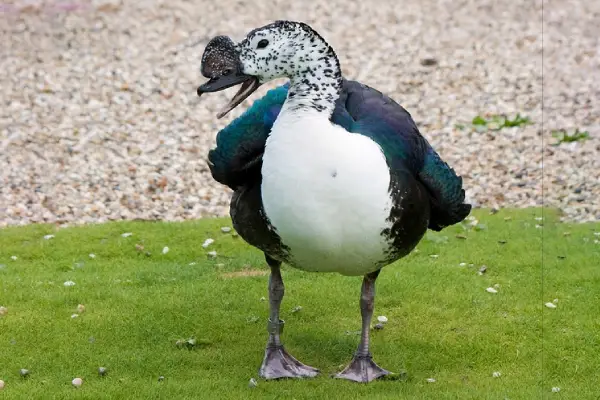Some duck species can exhibit an intriguing blend of elegance, adaptability, and beauty, making them a captivating subject for nature enthusiasts, birdwatchers, and researchers alike.
Notable examples of those are ducks with black bills, namely gadwalls, northern shovelers, common goldeneyes, hooded mergansers, and many others.
Whether you’re an avid waterfowl enthusiast or simply curious about the avian wonders that grace our wetlands, this article will introduce you to an array of black-billed duck species, each possessing its own unique characteristics and habitat preferences.
Table of Contents
Ducks With Black Bills
1. Gadwall

Gadwalls are very common and widespread dabbling ducks found in Europe, Asia, Africa, and North America. Common round lakes, ponds, and marshes, these fairly-large ducks can be seen in pairs or small flocks.
In North America, they breed along the Saint Lawrence River, the Great Lakes, Alberta, Saskatchewan, and the Dakotas, and extend southward to Kansas and westward to California, with an expanding range into eastern North America.
During winter, they migrate extensively, reaching as far as coastal Alaska, Central America, and even stretching eastward into Idaho, Kansas, Ohio, and Virginia.
Males have elegant gray plumage with puffy heads, black rear ends, and small white wing patches visible in flight. Females resemble mallards and are patterned with brown and buff.
What makes male gadwalls unique are their very distinctive, narrow black bills. Females, on the other hand, have yellowish ones with dark spots.
2. Blue-winged Teal

Blue-winged teals are small dabbling ducks found in North America. They breed from southern Alaska to Nova Scotia and extend southward to northern Texas. During winter, they migrate to the Pacific and Atlantic coasts, as well as the Caribbean islands and Central America.
The adult male displays a grayish-blue head with a white facial crescent, a light brown body with a white patch near the rear, and a black tail. The adult female has a mottled brown appearance and a whitish area at the base of the bill.
Both males and female blue-winged teals possess large black bills, sky-blue wing coverts, a green speculum, and yellow legs. These ducks are typically found in shallow wetlands or marshes, either in pairs or small flocks, sometimes together with other duck species.
3. Common Goldeneye

Common goldeneyes are medium-sized ducks found in North America, Europe, and Asia. In North America, they breed in the boreal forests of Canada and the northern USA, specifically in lakes and rivers, before migrating south to winter in protected coastal or inland waters.
With large heads and short tails, these ducks have striking black and white plumage. Their dark black-green heads are complemented by round white spots near their beaks, while the rest of their bodies showcase crisp black-and-white patterns. As their name suggests, their golden-yellow eyes add a touch of allure and help them stand out from a distance.
What also sets them apart are their distinctive beaks. Common goldeneyes have fairly small and narrow dark bills – in males, they are completely black, while females have a small yellowish patch at the tip.
Aggressive and territorial, these ducks engage in elaborate courtship rituals, where males arch their heads backward to touch their rumps, thrust forward, and create splashes with their feet to woo females. As skilled water divers, common goldeneyes forage underwater, feeding on crustaceans, aquatic insects, and mollusks.
These ducks are also common in Northern California; explore other birds found there on this link.
4. Barrow’s Goldeneye

Barrow’s goldeneyes are medium-sized sea ducks named after Sir John Barrow, a famous 18th-century explorer. Part of their scientific name refers to their unique-looking heads, coming from the Ancient Greek word “boukephalos” meaning “bullheaded.”
Adult males are mostly black and white and their dark backs contrast well with their white necks, breasts, bellies, and bright yellow eyes. Females have a dark chocolate color on their heads while the rest of their body is grayish with a white underbelly.
When it comes to their short bills, they are black in adult males and orange-yellow in females.
Despite being rather quiet, Barrow’s goldeneyes will make various sounds during their breeding season: low-volume squeaks, grunts, and croaks. They forage by diving and have a diet consisting of aquatic insects, crustaceans, and pond vegetation.
They breed in wooded lakes and ponds in northwestern parts of North America and some parts of eastern Canada and in Iceland. These ducks are migratory and will move to protected coastal waters or open inland waters of the northwestern USA during winter.
They are often found in mixed flocks with common goldeneyes that they resemble – Barrow’s goldeneyes have more black on their backs, a purple sheen on their heads (not green), crescent-shaped (not circular) white patches on their faces, and shorter bills.
5. Northern Shoveler

Northern shovelers are common ducks found in Europe, Asia, Africa, South, and North America. They breed in western North America and the Great Lakes region of the USA.
They are widespread and very hard to miss due to their unique beaks. Male shovelers have black shovel-like beaks bills while females have brownish-green ones.
Northern shovelers forage by sifting through the water with their huge beaks. They have small comb-like structures called lamellae along the edges that help filter out tiny crustaceans, seeds, and aquatic invertebrates from the water.
Northern shovelers are a rather silent species: males have clunking calls while the females will make quacks similar to mallards. These ducks are monogamous and drakes (males) will protect their territory and females against other males.
Northern shovelers are also commonly found in Northern Florida; read about other birds found there in this article.
6. Red Shoveler

Red shovelers are dabbling ducks native to South America. Breeding primarily in the southern half of South America, including regions like Tierra del Fuego, Chile, Argentina, and the Falkland Islands, they also have isolated populations in parts of Peru, Bolivia, and Paraguay.
Red shovelers possess distinctive spatula-shaped black bills, along with a green speculum and light blue upper wing converts. Male shovelers exhibit a range of colors from red to paler shades (including pink), while females typically have mottled brown plumage.
Red shovelers prefer habitats such as shallow lakes and pools with dense reed beds, intertidal mangrove swamps, marshes, and even brackish waters like coastal lagoons, deltas, and estuaries. While this species is relatively common and widespread, it may face challenges due to wetland degradation.
7. Cotton Teal

Cotton teals, small perching ducks also known as cotton pygmy geese, can be found in Asia, Africa, and Australia. They are one of the smallest duck species in the world and can weigh as little as 5.6 oz and measure just 10 inches in length!
Male cotton pygmy geese have very small black bills that are deep at the base, bright white heads and necks, dark crowns, a broad collar at the base of their necks, blackish backs, wing coverts, and scapular feathers with green and purple gloss. Females are plainer and have duller caps and brown eye-lines through their eyes.
Cotton pygmy geese are commonly found in pairs or larger groups, inhabiting waterbodies with lots of aquatic vegetation (freshwater wetlands, small ponds, and even farm dams). Scientists once discovered around 5,400 of these black and white ducks in one flock at Chilka Lake in India.
8. Knob-billed Duck

Knob-billed ducks, also known as African comb ducks, hold the distinction of being one of the largest duck species. With a length ranging from 22 to 30 inches and a weight of up to 6.4 pounds, these ducks reach impressive sizes.
Adults are easily recognizable, boasting white heads adorned with dark spots, white necks, and underparts, along with glossy black-blue upperparts. The males stand out further due to the presence of large black knobs on their black beaks, while the females lack these conspicuous features.
They inhabit freshwater rivers, lakes, and swamps across sub-Saharan Africa, India, and Southeast Asia. While generally quiet, these ducks may emit hisses, wheezes, grunts, or croaks when annoyed or during displays.
These ducks are social, forming small flocks during the wet season and larger groups of up to 100 individuals during the dry season. Like other species, knob-billed ducks may practice “dump nesting,” where multiple females lay their eggs in a single nest.
9. Cinnamon Teal

Cinnamon teals are small dabbling ducks found in North and South America. They breed in marshes and ponds of the western USA and some southwestern parts of Canada.
The species is migratory and they move to winter in Texas, California, Arizona, Mexico, the Caribbean, and northern parts of South America.
Male cinnamon teals are easy to identify by their long black beaks, cinnamon-brown plumage, brown backs, and red eyes. Females have mottled brown plumage, pale brown heads, brown eyes, and gray beaks.
They are mostly found in pairs or small flocks, occasionally together with other species of ducks. Cinnamon teals forage by dabbling and consume plants, insects, and mollusks.
10. Hooded Merganser

Hooded mergansers are small diving ducks with a striking appearance. They are native to North America and both sexes have crests that they can raise or lower.
Male hooded mergansers have black upperparts, white breasts, large heads with prominent white patches, and chestnut flanks. Male hooded mergansers also have long, narrow, and serrated black bills. Females are gray and brown and have puffy crests.
Hooded mergansers are common around inland lakes and ponds from spring to fall and then migrate to the east and west coasts of the USA to winter; they are usually in pairs or small flocks, but might occasionally mix with other ducks.
They hunt using their sight when underwater and can stay there for up to 2 minutes while chasing the prey! They have a third eyelid called a “nictitating membrane” that is transparent and allows them to see when submerged with no injury to the eyes; camels also have such eyelids, although they do not dive like their avian counterparts.
Summary
And there you have it, 10 very common duck species with black bills.
From the piercing yellow eyes and a contrasting black bill of common goldeneye to the massive shovel-like ones of northern shovelers, these ducks exemplify nature’s boundless creativity.
Hopefully, the next time you see them, you will recognize any of them with ease! And if you enjoyed our article, here are our other popular reads on animals: common ducks that have blue bills and common ducks that have orange bills